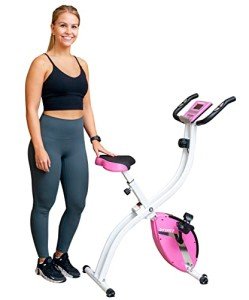15 Presents For Your Stationary Bikes Lover In Your Life
The Rise of Stationary Bikes: A Comprehensive Guide
In current years, stationary bicycles have risen in appeal, becoming a staple in homes, fitness centers, and fitness studios. Exercise Cycle Online , adaptability, and effectiveness in providing an excellent cardiovascular workout make them an attractive option for fitness enthusiasts of all levels. This article explores the types, advantages, features, and considerations concerning stationary bicycles, guaranteeing you have all the info you require to make a notified decision on this important fitness equipment.
Kinds Of Stationary Bikes
Before purchasing a stationary bike, it's important to understand the different types available, each catering to varying fitness goals and choices.
1. Upright Bikes
Upright bikes look like standard bicycles and appropriate for a more intense workout. Riders being in an upright position, engaging their core and leg muscles.
2. Recumbent Bikes
These bikes feature a reclined seating position that provides higher back support. They are perfect for those with back issues or people trying to find a more comfortable pedaling experience.
3. Spin Bikes
Designed for cycling enthusiasts, spin bikes provide a more intense workout experience, typically found in group classes. They include a heavy flywheel and adjustable resistance, permitting a vigorous workout.
4. Folding Bikes
For those with limited area, folding bikes offer a compact option. They can be easily kept away when not in usage, making them ideal for home residents or periodic users.
5. Smart Bikes
Leveraging technology, smart bikes link to apps or virtual cycling platforms, offering interactive workouts, live classes, and efficiency tracking.
Advantages of Stationary Bikes
Buying a stationary bike provides many health and wellness benefits. Here are some reasons why one might consider including this tool to their regimen:
1. Cardiovascular Health
Routine cycling can efficiently enhance cardiovascular fitness, assisting to enhance the heart, increase lung capability, and boost circulation.
2. Weight Loss
Stationary biking can assist in burning calories and shed excess weight. Depending on the strength, an individual can burn between 400 and 600 calories in an hour.
3. Low Impact
Cycling is low-impact, making it suitable for people with joint problems or those going through rehab. It enables a safe workout without putting undue tension on the joints.
4. Reinforcing Muscles
Cycling works various muscle groups, especially the legs, glutes, and core. Over time, it enhances muscle tone and strength.
5. Flexibility and Balance
Regular usage of a stationary bicycle can enhance total flexibility and balance as it motivates better posture and core engagement.
6. Hassle-free and Flexible
One of the best advantages of stationary bikes is the capability to exercise on your schedule. There's no requirement to commute to a gym; you can ride in the house, at any time of day.
Features to Consider When Choosing a Stationary Bike
When picking a stationary bike, a number of crucial functions need to be taken into account to ensure you get the best value and performance for your requirements.
1. Adjustable Resistance
Purchase a bike with adjustable resistance levels. It allows you to tailor your workout intensity as you progress in your fitness journey.
2. Ergonomic Design
Choose a bike that provides adjustable seat height and position to keep comfort throughout workouts. An ergonomic design reduces the threat of injury.
3. Entertainment Options
Think about bikes with integrated speakers or compatibility with music gadgets. This feature can help make workouts more enjoyable, especially throughout longer sessions.
4. Show Console
A great display screen console tracks necessary metrics such as time, range, speed, and calories burned. Some advanced models might also keep track of heart rate and sync with fitness apps.
5. Rate and Warranty
Stationary bicycles come in a variety of prices. Set a spending plan and look for models that provide a warranty, ensuring you are covered in case of mechanical problems.
FAQs About Stationary Bikes
Q1: How typically should I use a stationary bicycle for optimum outcomes?
A1: For ideal fitness results, go for at least 150 minutes of moderate-intensity cycling per week. This relates to about 20-30 minutes per session, 5 days a week.
Q2: Can stationary bicycles help build muscle?
A2: Yes, while stationary bicycles are mainly utilized for cardiovascular workouts, they can also help tone and strengthen the legs and core muscles, particularly with increased resistance.
Q3: Are stationary bicycles appropriate for beginners?
A3: Absolutely! Stationary bicycles can accommodate different fitness levels, with adjustable resistance settings and comfortable seating alternatives that make them beginner-friendly.
Q4: Do I require a special kind of bike for indoor cycling classes?
A4: While basic stationary bicycles can be utilized for indoor cycling classes, spin bikes are normally preferred for their much heavier flywheels and greater levels of resistance.
Q5: How can I maximize my stationary bike workouts?
A5: To optimize your results, think about mixing different workout routines, such as interval training, steady-state rides, and strength-focused cycling sessions.
Stationary bikes are an outstanding addition to anyone's fitness routine. They provide a versatile, effective, and low-impact method to enhance cardiovascular health, enhance muscles, and assist in weight management. With various types and functions available, it's important to assess private needs, choices, and spending plan before purchasing. Ultimately, including a stationary bicycle into your routine can be a substantial step towards a healthier, more active lifestyle.
